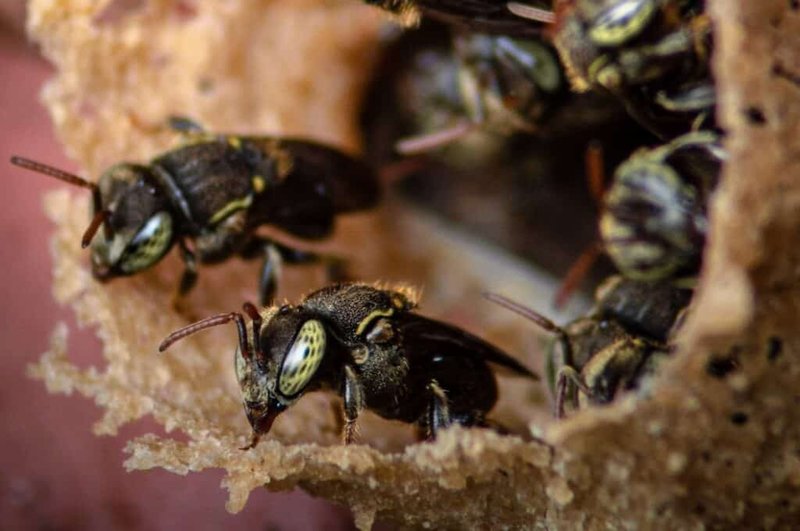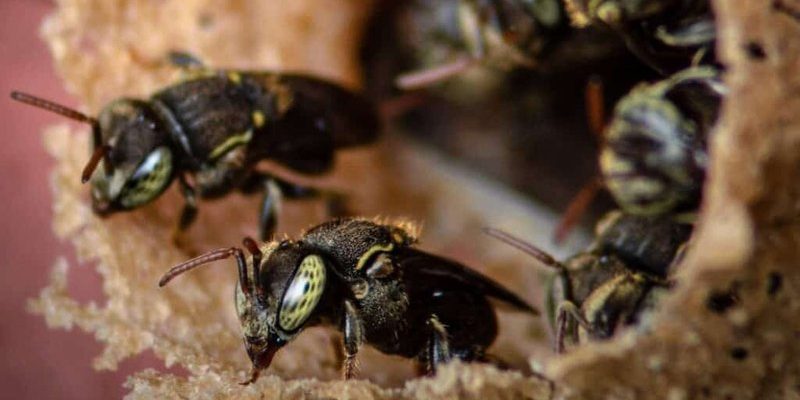
Identifying stingless bees can be a fun and educational experience, especially if you’re keen on observing nature or simply want to learn more about these fascinating insects. Unlike their more infamous cousins, these bees are generally harmless and are known for their unique behaviors and social structures. Today, we’ll delve into how to identify these charming pollinators, discussing their physical traits, habitats, and the subtle cues that can help you spot them in the wild.
What Are Stingless Bees?
Stingless bees belong to the tribe Meliponini, which consists of over 500 species worldwide. Unlike the more common honeybees, these bees don’t have a stinger, which makes them quite the mischief-makers in the bustling world of pollinators. Instead of using a sting for defense, they rely on their numbers and teamwork, often forming colonies that can range from just a few individuals to thousands.
One neat characteristic of stingless bees is their ability to produce honey, albeit in smaller quantities than honeybees. Their honey is known for its unique taste and medicinal properties—many native communities cherish it for various health benefits. So, in a way, stingless bees are like the underdogs of the bee world. They might not be as famous as their stinging relatives, but they play an equally essential role in pollination and biodiversity.
Physical Traits of Stingless Bees
When it comes to identifying stingless bees, start with their physical characteristics. These little guys are usually smaller than the common honeybee, and their bodies can vary in color from black to brown, sometimes with shades of yellow or metallic green. Their size, which can range from 2 to 15 millimeters, depends on the species. To the untrained eye, they might look similar to other flying insects, so here are a few key features to help you distinguish them.
First off, look for a broader head. Stingless bees have a distinctive head shape, often wider than that of honeybees, with large, round compound eyes. Their compound eyes help them navigate and forage for food efficiently. You’ll also notice their legs have a unique structure; they often have fuzzy hairs that collect pollen. This is essential for their role in pollination and can help you recognize them when they buzz past your shoulder.
Next, focus on their wings. While honeybees have a certain sheen to their wings, stingless bees possess wings that can appear slightly smoky or less translucent. If you see a bee flitting around with these features, you might just have a stingless friend nearby!
Where to Find Stingless Bees
You might be wondering where these elusive bees like to hang out. Stingless bees thrive in tropical and subtropical regions, particularly in areas rich in flowering plants. They enjoy habitats like rainforests, gardens, and even urban parks. If you’re in regions like Central or South America, Africa, or Southeast Asia, you’re in prime stingless bee territory.
These bees often build their nests in tree cavities, hollowed logs, or even in the ground. Their nests can look like small clumps of wax, almost resembling miniature beehives. If you’re peeking into flower patches or closely observing gardens, keep an eye out for any holes or small entrances leading to these nests. And remember, stingless bees are usually more active during the day when flowers are blooming and temperatures are warm.
Behavior of Stingless Bees
Understanding the behavior of stingless bees can also give you clues to identify them. These bees are quite social and enjoy a communal lifestyle. They live in colonies where division of labor is key—some bees forage for nectar, while others tend to the young or guard the hive. You might find them busy buzzing around flowers, collecting pollen, and sharing their finds with fellow colony members.
Honestly, watching them work together is mesmerizing. They often perform a little dance to communicate the location of food sources to their hive mates. This behavior is similar to what honeybees do, but stingless bees often have their unique twist. If you observe them closely, you might see them forming long lines as they return to the nest, carrying tiny pollen balls.
Another fascinating aspect is their lack of aggression. While a honeybee might sting if it feels threatened, stingless bees are generally peaceful and will often retreat instead of confronting a potential threat. This makes them enjoyable to watch without the worry of being stung.
How to Spot the Differences Between Stingless Bees and Honeybees
As you dive deeper into the world of bees, you may notice that stingless bees can easily be confused with honeybees. Here are some differences to help you out:
- Size: Stingless bees are usually smaller than honeybees.
- Body Shape: Stingless bees have a broader head and a more robust, rounded body.
- Wings: The wings of stingless bees tend to be less transparent and more opaque.
- Behavior: Stingless bees are less aggressive and more social, often foraging in groups.
By paying attention to these details, you’ll soon become a pro at spotting the differences. Imagine you’re in your backyard or at a local park; next time you see a bee buzzing around, you’ll likely have a better idea of what type you’re dealing with.
Conserving Stingless Bees and Their Habitats
As we learn to identify and appreciate stingless bees, it’s essential to think about ways to protect them. These insects are vital for pollination, and their decline poses a risk to many plants and ecosystems. Climate change, habitat destruction, and pesticide use are significant threats to their populations.
One simple way to help is by creating a bee-friendly garden. This can include planting native flowering plants, providing water sources, and avoiding chemical pesticides that harm these delicate creatures. Just think of how fulfilling it is to nurture a space where native bees can thrive! Not only will you create a haven for them, but you’ll also enjoy vibrant flowers and perhaps even a taste of their unique honey if they decide to visit your yard.
In addition, consider spreading the word about the importance of stingless bees. Teaching others how to identify them can create a community of advocates for their protection. Every small action counts!
Final Thoughts on Identifying Stingless Bees
Identifying stingless bees opens up a world of wonder and appreciation for these vital pollinators. Their unique traits, social behaviors, and peaceful nature make them a delightful aspect of any garden or wild setting. As you explore the outdoors, remember to take it slow. Watch for their distinctive features and behaviors, and enjoy the beauty of these non-stinging little wonders.
So, next time you’re out and about, keep your eyes peeled for those busy little bees. You might find yourself enchanted by their gentle presence and their essential role in our ecosystem. Happy bee-spotting!

